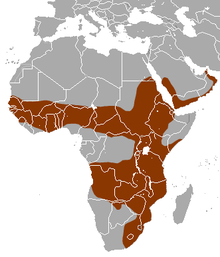White-tailed mongoose
| White-tailed mongoose | |
|---|---|
 |
|
| Scientific classification | |
| Kingdom: | Animalia |
| Phylum: | Chordata |
| Class: | Mammalia |
| Order: | Carnivora |
| Family: | Herpestidae |
| Subfamily: | Herpestinae |
| Genus: |
Ichneumia I. Geoffroy Saint-Hilaire, 1837 |
| Species: | I. albicauda |
| Binomial name | |
|
Ichneumia albicauda G. Cuvier, 1829 |
|
| Subspecies | |
|
|
 |
|
| White-tailed mongoose range | |
The white-tailed mongoose (Ichneumia albicauda) is the largest species in the mongoose family (Herpestidae). It is the only member of the genus Ichneumia.
The white-tailed mongoose lives in most of Africa south of the Sahara, and the southern portion of the Arabian Peninsula. They live in a wide range of habitats, from semi-desert to savanna woodland, but avoid moist areas like the Congo River basin or extremely arid areas. They prefer areas of thick cover, such as the edges of forests and brushy streams.
The white-tailed mongoose attains a weight range of 6.4-9.2 lb (2.9-4.2 kg), has a head-and-body length of 21-28 in (53–71 cm) and a tail length of 16-19 in (40–47 cm). Its legs are relatively long for a mongoose. The head is very long and narrow and tapers to a point. Its large, rounded ears are set low on the sides of the head. It has a yellow to tan coloration on its body, with long black guard hairs, giving it an overall grizzled grey appearance. The legs and arms are black from the elbow/knee down. The base of the large, bushy tail is brownish yellow, and is white on the latter half. The tail may make up to 40% of the body length and tapers to a point. They lack hair on their upper lip and their hands from the palms to the wrists. Females have four teats.
The genus name, Ichneumia, is derived from the Greek ichneumon, which means 'tracker'. This name also happens to be the species and common name for the Egyptian mongoose (Herpestes ichneumon). The species name, albicauda, is derived from the Latin words albus, meaning 'white', and cauda, which means 'tail'.
The white-tailed mongoose feeds mostly on insects, but will feed on a wide variety of other foods as well. Locusts, beetles, and mole crickets make up the majority of their diet. Rats, mice, shrews, lizards, snakes, small birds are also eaten, along with the occasional fruits and berries. The eggs of birds are also eaten; they will break open the egg by throwing it between its hind legs against a rock or other hard object. They have been known to raid chicken houses in areas where domestic poultry is raised.
...
Wikipedia

